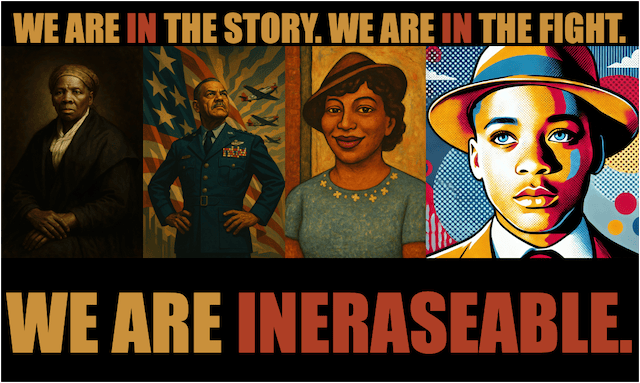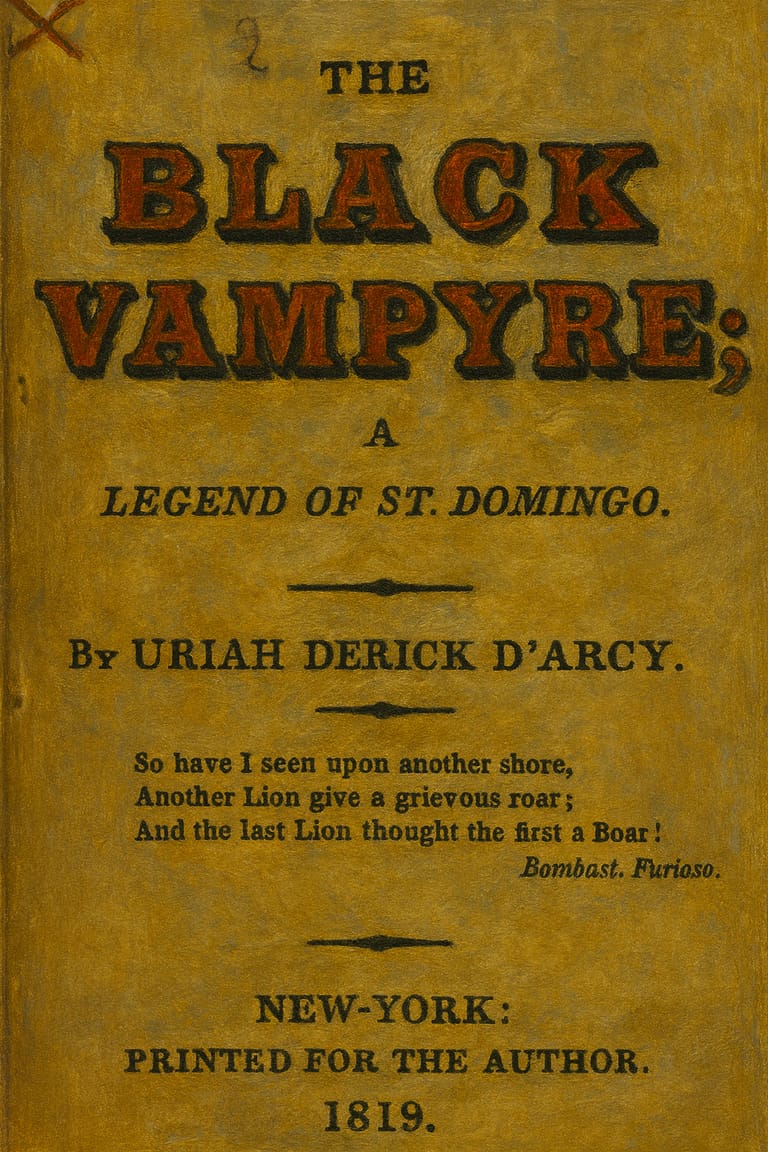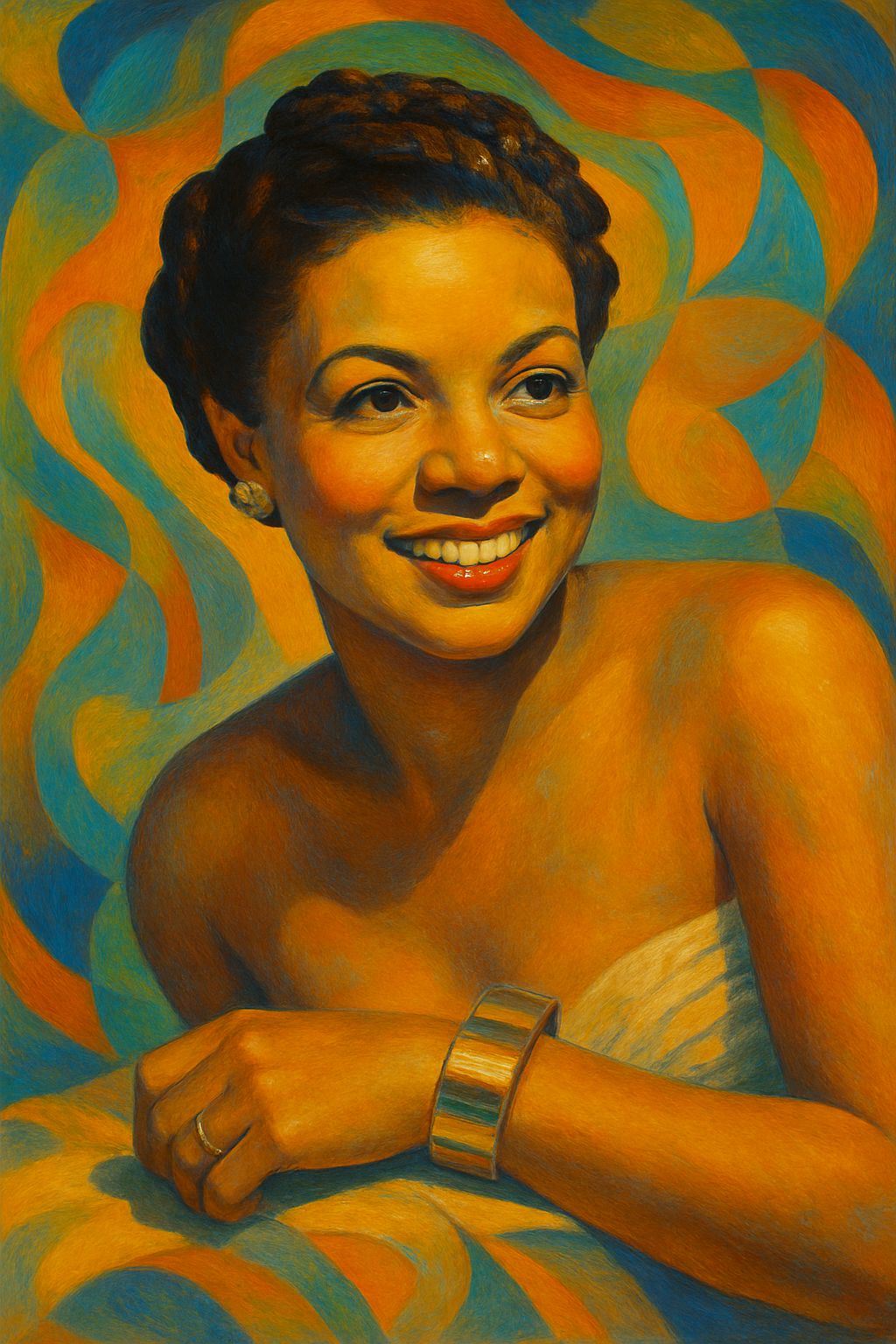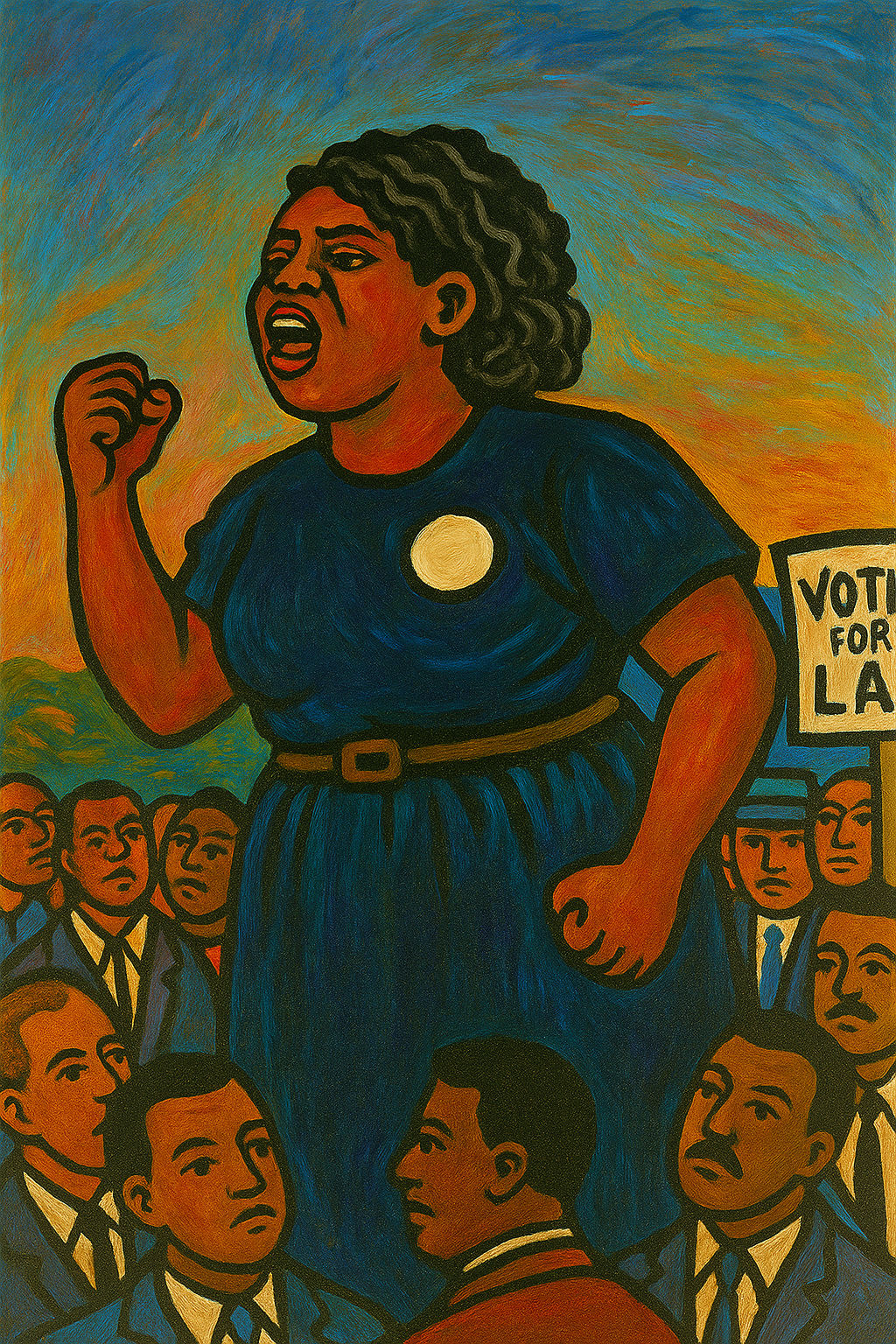The INerasable INsider

Welcome IN…
Fall is here, and so is our second issue of the INerasable INsider. I want to start by saying thank you — the response since our launch has been incredible. From new subscribers to shares, from the first purchases to the kind words you’ve sent, it’s clear this project is resonating.
Every day, it feels like history is under attack. But together, we’re proving something powerful: when we honor legacies, when we share stories, when we refuse to be silent, we are INerasable.
Here’s what you’ll find in this month’s issue:
INerasable INsight: The Black Vampyre — America’s first vampire story, rooted in rebellion and freedom.
IN the moment: John Brown’s Raid on Harper’s Ferry and the beginnings of the Civil War.
Bonus INsight: Hazel Scott — the first Black woman to host a national TV show, and the price she paid for breaking barriers.
IN the Spotlight: Fannie Lou Hamer — a birthday tribute to one of the fiercest voices in the fight for equality.
IN the Near Future: Sneak peek at new “I Am INerasable” hats, sweatshirts, and toddler tees coming to the site.
As the nights grow longer and the air turns crisp, remember — some stories refuse to stay buried. Their power rises again and again, reminding us that truth, legacy, and history are forever...
IN the shadows. IN the light. INerasable.
From the haunted halls of history — with thanks,
Stafford H. Burns
INerasable INsight Feature Story
IN the Shadows: The Black Vampyre: A Legend of St. Domingo

“The Black Vampyre” (1819): Where horror and history collide.
“Even the dead shall rise again —
not to terrify the innocent, but to judge the guilty.”
Halloween usually brings to mind costumes, candy, and ghost stories — but here’s one that flips the script: the very first American vampire story wasn’t just about horror; it was about slavery, rebellion, and freedom.
Published in 1819 under the pseudonym Uriah Derick D’Arcy, The Black Vampyre: A Legend of St. Domingo tells the tale of an enslaved African who, after being killed by his enslaver, rises from the grave as a vampire to take revenge. Instead of haunting European castles, this vampire stalks plantations, coastlines, and colonial halls of power — hunting those who once claimed ownership of his body.
Read the full story on Wikipedia
A Revolution in Disguise
When The Black Vampyre appeared, the world was still reeling from the Haitian Revolution (1791 – 1804) — the first successful revolt of enslaved people in the Western Hemisphere. D’Arcy’s gothic tale turned that history into allegory, capturing white America’s deepest fear: that the enslaved might rise again, unkillable, uncontainable, demanding justice.
In its shadowed pages, vampirism becomes metaphor. The monster isn’t evil; he’s righteous. He rises not to destroy innocence, but to expose guilt — a radical inversion for a country still steeped in human bondage.
Why It Matters — Then and Now
Most early vampire tales feature pale European aristocrats feeding on peasants. Here, the vampire is Black, a symbol of power reclaimed.
It’s an early example of using horror to tell truth — showing that the scariest parts of history aren’t supernatural, they’re systemic.
Its existence proves that, even two centuries ago, writers were using art to confront America’s contradictions between freedom and enslavement.
The Mysterious Author
No one knows who “Uriah Derick D’Arcy” really was. Some scholars credit Robert C. Sands or Richard Varick Dey, both New York writers who used pseudonyms to veil politically dangerous ideas. Whoever D’Arcy was, his work stands as an act of literary rebellion.
Scholarly analysis on COVE Collective
INteresting Fact
The Black Vampyre was published nearly 80 years before Dracula and placed a Black vampire at the center of America’s first vampire myth — a creature not of horror, but of history.
IN the Moment: John Brown at Harpers Ferry
John Brown’s Harper’s Ferry raid

In October 1859, abolitionist John Brown led a daring raid on the federal arsenal at Harpers Ferry, Virginia, hoping to spark a nationwide uprising that would end slavery once and for all. Though the raid failed and Brown was captured, his courage ignited a moral fire across the nation.
Frederick Douglass called him “a man who could be counted on in any storm.” Brown’s defiance split the country — inspiring abolitionists and terrifying slaveholders — and his trial became a national reckoning.
When Brown was executed that December, church bells rang in the North, and militias drilled in the South. His actions deepened the divide between freedom and bondage, pushing a fragile nation closer to war. Less than two years later, the Civil War began — and many would say it started in spirit at Harpers Ferry.
John Brown’s stand reminds us that the fight for justice often begins with one person refusing to wait for permission — a truth that echoes through every generation that dares to rise.
IN defiance. IN faith. INerasable.
INsight Feature Story
Hazel Scott (1920-1981)
The Jazz Virtuoso Who Defied Hollywood and McCarthyism
Back in September, we had planned to tell you about a groundbreaking “first” in Black history that also ended in heartbreak. But when Robert Redford passed, we chose to honor his legacy in our INaugural issue, and this story had to wait. Now, it’s time to give it the spotlight it deserves.
In July 1950, Hazel Scott became the first Black woman in America to host her own national TV program, The Hazel Scott Show on the DuMont Network. Three nights a week, she sat at the piano and performed jazz, classical, and popular music with the brilliance that had already made her a household name. For a moment, it seemed like she had cracked open a door television had kept firmly shut.
But the run was short-lived. Just three months later, on September 29, 1950, the show aired its final episode. Scott had been named in Red Channels, the anti-communist blacklist that destroyed countless careers during the Red Scare. Even though she boldly testified before Congress to clear her name, advertisers pulled out, and her show was gone.
Hazel Scott’s story is a reminder of two truths: first, how quickly progress can be punished when it threatens power, and second, how even short-lived victories can echo across generations. She was a child prodigy at Juilliard, a fierce advocate who refused to perform for segregated audiences, and a star whose brilliance couldn’t be dimmed by politics.
Her show may have lasted only three months, but its legacy is INerasable.
INteresting Facts about Hazel Scott
She auditioned for Juilliard at age 8 — and got in.
She refused to play segregated venues, turning down lucrative gigs rather than compromise her principles.
She often performed on two grand pianos at once, playing in harmony with both hands stretched across. Alicia Keys honored Ms. Scott at the 2019 Grammys, performing on 2 pianos as she would have.
She was married to Congressman Adam Clayton Powell Jr., one of the most influential Black politicians of his era.
IN melody.
IN memory.
INerasable.
IN the spotlight
Fannie Lou Hamer (1917-1977)
The Voice That Wouldn’t Be Silenced
On October 6, 1917, Fannie Lou Hamer was born in rural Mississippi — the youngest of twenty children, the daughter of sharecroppers who worked sunup to sundown for next to nothing. By the time she was six, Hamer was picking cotton; by her teens, she could gather hundreds of pounds a day. Poverty wasn’t just her backdrop — it was the weapon used to keep her and her community in line.
But Hamer had a fire that could not be contained. In her forties, after attending a meeting about voting rights, she decided she was done living in fear. When she tried to register to vote in 1962, she was fired from the plantation where she’d worked for nearly two decades. Instead of stopping her, that act of punishment became the spark that ignited her life’s mission.
We often remember her for her fiery declaration: “I’m sick and tired of being sick and tired.” But there’s more to her story — things we don’t talk about enough.
In 1961, Hamer was sterilized without her consent while undergoing surgery — a brutal act of medical racism so common it had a name: a “Mississippi appendectomy.” Instead of silencing her, it deepened her resolve to speak for those who could not.
She co-founded the Mississippi Freedom Democratic Party (MFDP) to challenge the all-white state delegation at the 1964 Democratic National Convention. Her televised testimony — delivered through tears and unflinching truth — described the violence she endured just for trying to vote. Millions watched, and for a brief, transformative moment, America saw the face of its conscience.
Beyond politics, Hamer believed in community power. She founded the Freedom Farm Cooperative, helping Black families grow their own food and gain economic independence. She understood that true freedom wasn’t just about a ballot — it was about self-sufficiency, dignity, and collective care… community.
Hamer’s life reminds us that resistance isn’t only about marches and speeches. It’s also about planting seeds, feeding neighbors, and building something that lasts.
This October, as we honor her birthday, we remember a woman who refused to be defined by fear — one whose voice still echoes like a hymn of defiance and hope.
INteresting Facts about Fannie Lou Hamer
She sang for strength. Hamer’s powerful voice led freedom songs at marches and mass meetings, steadying protesters’ nerves and giving courage in the face of violence.
She was nearly killed for trying to vote. In 1963, she was arrested and brutally beaten in a Mississippi jail — injuries that caused lifelong damage. Yet she refused to stop fighting.
She founded a “pig bank.” Through her Freedom Farm Cooperative, families could borrow pigs, raise them, and return piglets to help others — a creative, community-based anti-poverty plan.
She helped register thousands of voters — even when she couldn’t vote herself. Before the Voting Rights Act, she traveled across the South running registration drives for others who’d been denied.
She understood intersectionality before it had a name. Hamer fought not just racism, but also sexism, poverty, and economic exploitation — insisting that freedom had to include everyone.
“Nobody’s free until everybody’s free.”
IN her courage.
IN her conviction.
INerasable.
IN the near future
Notes from the INside
Big news — our INerasable collection just got a fall and winter glow-up!
We’ve added new hats, hoodies, t-shirts, stickers, and kids’ and baby gear so everyone can proudly say:
“I Am INerasable.”
This drop isn’t just about merch — it’s about movement.
It’s about wearing our history, carrying our legacy, and sparking conversations everywhere you go. Whether you’re headed to class, a family gathering, or a chilly night out, you can represent the stories that shaped us and the heroes who refused to be erased.
But that’s not all. This is just the beginning for INerasable.
In the coming months, we’ll be rolling out educational workbooks, posters, notebooks, and more — new ways to honor legacies, share stories, and keep history alive in classrooms, homes, and communities.
So as the nights grow longer and Halloween creeps near, remember: even in the darkness, light — and history — refuse to fade.
👉 Visit WeAreINerasable.com to check out our new fall line and grab something bold for the season.
👉 Follow us on Facebook, Instagram @weareinerasable, and Bluesky WeAreINerasable for updates, new drops, and daily doses of legacy.
👉 Tell your family, friends, and neighbors — the story grows every time you share it.
This is just the beginning — and with your support, small things grow into powerful things.
Because history is:
IN Me.
IN You.
INerasable.
This Halloween, remember: ghosts fade, but legacies don’t. So be bold. Be brave. Be IN the story — even in the dark.
"The truth is powerful and it prevails"
— Sojourner Truth


